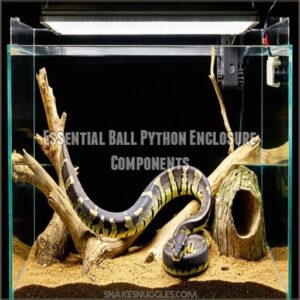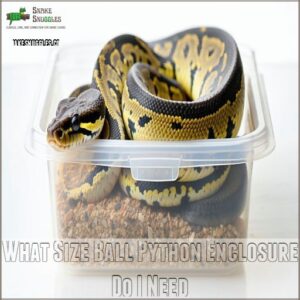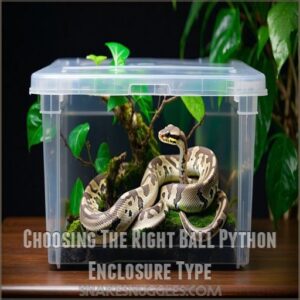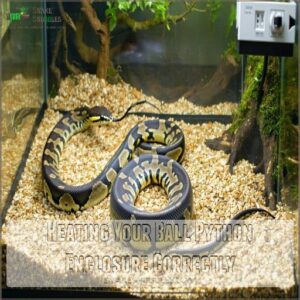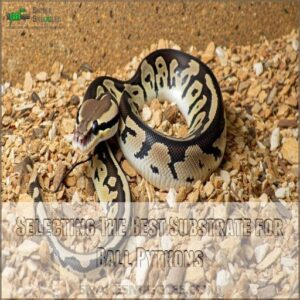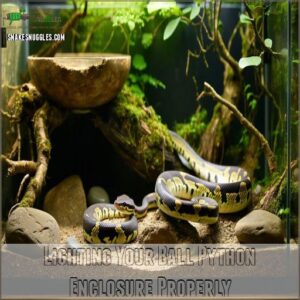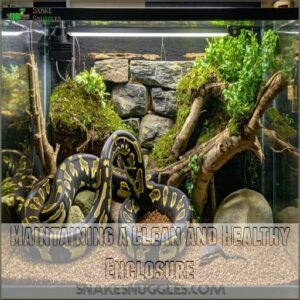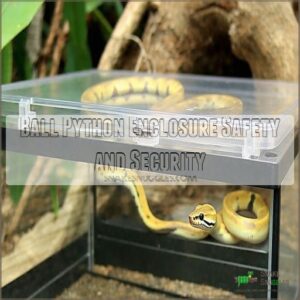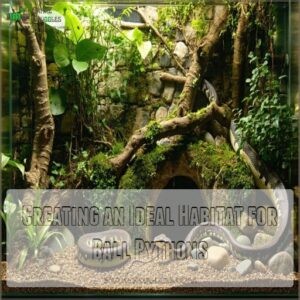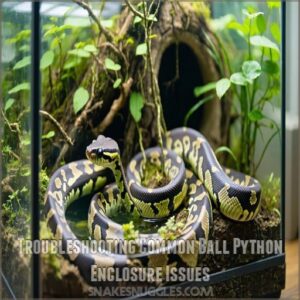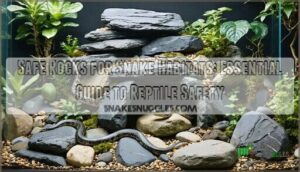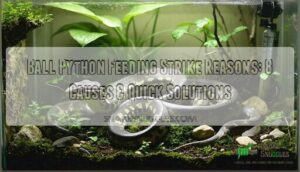This site is supported by our readers. We may earn a commission, at no cost to you, if you purchase through links.
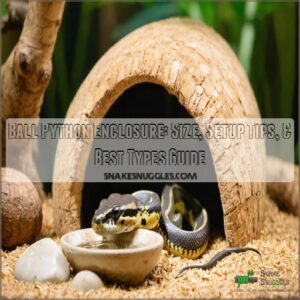 Your ball python enclosure needs to grow with your snake, just like kids outgrow their shoes.
Your ball python enclosure needs to grow with your snake, just like kids outgrow their shoes.
Start small with a 10-gallon tank for youngsters, then upgrade to 20-30 gallons for adults.
You’ll want to create a cozy space that’s not too roomy – think of it as a snug studio apartment rather than a mansion.
The perfect setup includes two snug hides, proper heating, and the right substrate to maintain 60% humidity.
Getting these basics right will keep your scaly friend as happy as a snake in a… well, perfectly sized enclosure.
There’s quite a bit more to mastering the art of snake-home design.
Table Of Contents
- Key Takeaways
- Essential Ball Python Enclosure Components
- What Size Ball Python Enclosure Do I Need
- Choosing The Right Ball Python Enclosure Type
- Heating Your Ball Python Enclosure Correctly
- Selecting The Best Substrate for Ball Pythons
- Lighting Your Ball Python Enclosure Properly
- Maintaining a Clean and Healthy Enclosure
- Ball Python Enclosure Safety and Security
- Creating an Ideal Habitat for Ball Pythons
- Troubleshooting Common Ball Python Enclosure Issues
- Frequently Asked Questions (FAQs)
- Who makes a Python enclosure?
- How do I set up a ball python enclosure?
- Why should you choose a ball python enclosure?
- How big should a ball python enclosure be?
- What is the best snake enclosure for a ball python?
- How hot should a ball python enclosure be?
- What size enclosure does a ball python need?
- What is the best enclosure for ball pythons?
- Is a 75 gallon tank too big for a ball python?
- What do ball pythons need in their tank?
- How often should I mist my ball python enclosure?
- Can multiple ball pythons share one enclosure?
- Are glass tanks better than plastic tubs?
- Should my enclosure have live or artificial plants?
- Do ball pythons need UVB lighting in captivity?
- Conclusion
Key Takeaways
- You’ll need to start with a 10-gallon tank for young ball pythons and upgrade to 20-30 gallons for adults, providing enough space without making it overwhelming.
- You should maintain a temperature gradient with a basking spot of 88-92°F and a cool side of 78-80°F, while keeping humidity between 55-65% for optimal health.
- You must include at least two secure hides, proper heating (like a thermostat-regulated heat pad), and appropriate substrate (such as aspen shavings or coconut fiber) that maintains humidity.
- You’ll need to clean your snake’s enclosure regularly, with daily spot cleaning, weekly water bowl changes, and complete substrate replacement every 3-4 months to prevent health issues.
Essential Ball Python Enclosure Components
Creating the perfect home for your ball python means making sure it has all the right components, like a cozy hide, a warm spot to lounge, and even tiny food dishes.
Think of it as setting up a mini luxury hotel room for your snake—it mightn’t need room service, but it sure appreciates the right lighting and a comfy substrate!
Water and Food Dishes
Ever wonder how to keep your ball python’s water and food dishes just right? Start with the right-sized dishes to match your python’s needs and make sure they’re of good quality.
- Dish Size: Large enough for drinking but not too bulky.
- Water Quality: Fresh and clean.
- Placement: Away from heat.
- Cleaning Frequency: Weekly.
- Dish Types: Ceramic or heavy plastic.
Adequate Substrate
Choosing the right substrate is key for your ball python’s happiness!
Think of it as their comfy carpet.
Good choices include aspen shavings, coconut fiber, or cypress mulch.
Avoid dusty options that could cause respiratory problems or be accidentally eaten.
Aim for a depth that allows for burrowing and humidity control, considering a substrate for humidity that matches your Ball Python’s natural habitat. Aim for a depth that allows for burrowing and humidity control.
Regular cleaning prevents bacteria buildup, keeping your snake’s home healthy and happy.
Proper substrate is a cornerstone of a great ball python enclosure setup.
Heat Sources
Heat sources are your ball python’s lifeline, often mimicking warm rocks in the wild.
For ideal heat control, consider using a thermostat-regulated heat source, like a halogen flood bulb.
Consider heat pad types placed beneath one-third of the tank to gently warm your snake’s underside.
Skip the heat lamp alternatives for a simpler setup.
Use thermostat control to maintain precise temperatures.
Monitoring with a hygrometer guarantees perfect humidity.
Keep your python comfy, not crispy!
Hides and Decorations
Ball python enclosures thrive with thought-out hide types and decorations.
They love playing hide and seek, so be creative with:
- Hide materials: Use non-toxic woods or DIY hides.
- Hide placement: Spread hides around the enclosure.
- Decoration benefits: Boost your python’s happiness with logs and rocks.
- Ball python decorations: Safe plants can make the space homier.
Basic Lighting
Think of lighting in a ball python enclosure like setting the mood for a cozy evening at home.
Mimic day/night cycles by using low-intensity light sources for about 12 hours a day.
Avoid blasting your snake with too much brightness—overlighting can stress them out.
Position lights to make sure even coverage, keeping your scaly friend feeling secure and comfy.
What Size Ball Python Enclosure Do I Need
When setting up your ball python’s home, size matters just as much as the cozy extras.
Young snakes, with their curious demeanor, thrive in smaller spaces like a 10-gallon tank.
You can find a variety of tank sizes and accessories like heating pads and hides on websites like Chewy.
As they age and grow (yes, they grow faster than you’d think!), aim for a 20-gallon tank, giving them room to stretch but not get lost.
Imagine your ball python enjoying the nooks and crannies, safely exploring its enchanted jungle.
Adult ball pythons prefer expansive territories, so upgrading to a 30 or 40-gallon enclosure is wise.
Remember, it’s like moving from a snug family car to a spacious SUV.
Bigger enclosures require added hiding spots for a secure, ball python-approved habitat.
Choosing The Right Ball Python Enclosure Type
When choosing the right ball python enclosure, you’ll find options abound—from plastic or PVC cages to classic glass tanks and even homemade designs.
Each type has its quirks, so think about your pet’s needs and your own setup skills—just remember, even snakes prefer a bit of personal space!
Plastic or PVC Cages
Plastic or PVC cages, the unsung heroes of snake housing, offer plenty of perks for your ball python.
They’re durable, easy to clean, and often cost-effective.
If you’re looking for specific examples, check out popular options for a plastic ball python enclosure.
Consider these benefits:
- Pros: Lightweight and stackable
- Cons: Can miss visual appeal
- Durability: Long-lasting materials
- Cleaning: Simplifies maintenance
- Cost: Budget-friendly choice
Perfect for understanding snake enclosures!
Glass Tanks
Glass tanks remain a popular choice for ball python enclosures, offering excellent visibility and durability.
You’ll find them readily available in pet stores, typically ranging from 20 to 40 gallons.
While they’re great for maintaining proper humidity levels, you’ll need to monitor the temperature closely.
The main drawback? They’re heavier than plastic alternatives and can crack if dropped.
A secure screen top is essential.
Wooden Enclosures
Wooden enclosures offer natural insulation and excellent humidity retention for your ball python.
They’re perfect if you live in a cooler climate since wood maintains heat better than glass or plastic.
However, you’ll need to seal the wood properly to prevent moisture damage and mold growth.
Consider melamine-coated options for better durability.
Add proper ventilation holes and make sure doors fit tightly to prevent escapes.
Homemade or Customized Cages
While wooden vivariums offer charm, building your own custom enclosure lets you create the perfect home for your ball python while saving money, often 40-60% less than commercial options as seen in DIY snake cage ideas.
Here’s what to think about for a successful DIY project:
- Use non-toxic materials like PVC panels or melamine-coated wood
- Install proper ventilation with mesh panels or drilled holes
- Make sure all edges are sealed against humidity
- Create access points for easy cleaning and maintenance
The beauty of DIY? You’ll know every inch of your snake’s home inside and out.
Heating Your Ball Python Enclosure Correctly
You’ll need to heat your ball python’s enclosure properly to keep your scaly friend happy and healthy, just like they’d be basking on sun-warmed rocks in the wild.
Whether you choose a heating pad or heating tape, you’ll want to apply it to one-third of the tank’s glass bottom to create the perfect warm spot for your python to digest and thrive.
Heating Pad Vs Heating Tape
Now that you’ve picked your enclosure, let’s talk about keeping your ball python cozy.
When it comes to heating options, you’ll typically choose between heating pads or heating tape.
Heating pads are ready-to-use and perfect for beginners, but they can be pricier and bulkier.
Heating tape is cheaper and more customizable, though you’ll need some DIY skills to install it properly.
Both options work great when set up correctly.
Heating The Glass Bottom
Properly placing your heating pad or tape under the glass bottom of your ball python’s enclosure mimics their natural behavior of basking on sun-warmed rocks.
You’ll want to position the heater on one end, covering about one-third of the tank’s bottom surface.
This setup creates a natural warmth gradient that lets your snake regulate its body temperature just like it would in the wild.
Maintaining Proper Temperature
Your ball python’s comfort depends on maintaining the right temperature zones.
To make sure you’re providing the best environment, consider using a thermal gradient setup, which allows your snake to thermoregulate by moving between warm and cool zones.
Keep the basking spot at 88-92°F and the cool side at 78-80°F by adjusting your heater’s placement.
Monitor these temps with two reliable thermometers – one for each end.
You’ll know you’ve nailed it when your snake moves naturally between zones, just like they’d in the wild.
Selecting The Best Substrate for Ball Pythons
You’ll need to choose the right substrate to keep your ball python comfortable and healthy, just like picking the perfect bedding for your own bed.
From classic options like aspen shavings to modern choices like coconut fiber, you’ll find several safe materials that help maintain proper humidity while making cleanup easier for you.
Avoiding Dusty or Ingestible Substrates
Safety-conscious snake owners know that choosing the right substrate goes beyond just picking what looks good.
When selecting bedding for your ball python, steer clear of dusty materials like fine sand or calcium-based substrates that can irritate their respiratory system.
Also avoid small, loose particles they might accidentally swallow during feeding time.
Think of substrate like your snake’s carpet – it should be comfortable and safe.
Aspen, Coconut Fiber, and Cypress Mulch
Popular substrates like aspen, coconut fiber, and cypress mulch each bring something special to your ball python’s home.
Aspen’s affordable and great for burrowing, but it doesn’t hold moisture well.
Coconut fiber excels at humidity control and costs a bit more, while cypress mulch strikes a nice balance – it’s moisture-friendly, long-lasting, and won’t break the bank.
Choosing the right substrate is vital, as it mimics natural habitat and supports the snake’s burrowing instincts.
Just remember to spot-clean weekly and replace them every few months.
Bio-Active Soil and Paper Towels
Bio-active soil brings a natural touch to your ball python’s home, complete with beneficial microorganisms that break down waste.
Think of it as a mini-ecosystem that’ll handle some cleaning for you.
Paper towels, while less flashy, offer a budget-friendly and super-clean option that’s perfect for monitoring health and spotting issues early.
Both choices work great – it’s all about what fits your setup and style.
Lighting Your Ball Python Enclosure Properly
You’ll need to set up proper lighting in your ball python’s enclosure to create a natural day-night cycle that keeps your scaly friend healthy and active.
Ball pythons don’t require special UV lighting like some other reptiles.
You’ll want to maintain regular light periods that match their natural environment.
Mimicking Day and Night Cycles
Your ball python needs regular day and night cycles just like in the wild.
You’ll want to maintain a consistent 12-hour light and 12-hour dark schedule to help your snake stay healthy and active, and choosing the right snake cage lighting options can greatly impact their overall well-being.
Setting up a timer makes this effortless – think of it as giving your python its own personal sunrise and sunset.
This natural rhythm helps regulate their feeding, digestion, and overall well-being.
Basic Lighting Options
While daylight cycles set the stage, selecting the right lighting equipment makes all the difference.
Here are three top picks for your ball python’s home:
- Low-wattage LED strips that mimic natural sunlight
- Reptile-specific daylight bulbs with built-in timers
- Ambient room lighting (if you’ve got multiple tanks)
For most setups, a simple LED light strip mounted on the tank’s lid does the trick – nothing fancy needed here!
Avoiding Overlighting
Too much light can stress out ball pythons, so finding the right balance is important.
Keep lighting moderate and indirect – think gentle sunlight rather than harsh spotlights.
A simple LED or fluorescent light that mimics natural daylight cycles works perfectly.
Skip UVB bulbs since ball pythons don’t need them, and never place heat lamps directly above their favorite hiding spots.
Maintaining a Clean and Healthy Enclosure
You’ll need to clean your ball python’s enclosure regularly to prevent health issues and make sure your scaly friend stays happy in their home.
Daily spot-cleaning and replacing the substrate every few months will create a fresh, comfortable environment.
Regular Cleaning Schedule
Keeping a ball python’s home clean isn’t just about looks – it’s about their health too.
Set up a weekly cleaning routine that includes changing their water bowl, checking humidity levels, and wiping down surfaces with reptile-safe cleaner.
Mark your calendar for a deep clean every month, where you’ll sanitize decorations and replace about half the substrate.
This schedule prevents bacteria buildup and keeps your snake comfortable.
Spot-Cleaning After Defecation
- Remove droppings and soiled substrate immediately using disposable gloves and a small scoop
- Disinfect the area with a reptile-safe cleaner, letting it dry completely
- When choosing a reptile-safe cleaner, consider shopping from online stores like reptile safe cleaners.
- Add fresh substrate to the cleaned spot, matching the depth around it
Replacing Substrate Every 3-4 Months
While your ball python’s substrate might look clean on the surface, it’s really important to replace it completely every 3-4 months.
This deep clean helps prevent harmful bacteria buildup and maintains proper humidity levels.
You’ll want to remove all substrate, sanitize the enclosure with a reptile-safe cleaner, and add fresh bedding.
Think of it as giving your snake’s home a seasonal refresh.
Ball Python Enclosure Safety and Security
You’ll need to make your ball python’s home as escape-proof as possible since these clever reptiles can squeeze through surprisingly small gaps.
To keep your scaly friend safe and secure, you’ll want to focus on three key areas: preventing escape attempts with secure screen tops, using only non-toxic materials in the enclosure, and housing your python alone since they’re happiest living the solo life.
Avoiding Cohabitation
Many ball python owners wonder if they can house multiple snakes together, especially considering the potential benefits of cohabitation and socialization, but here’s the truth: ball pythons are solitary creatures that thrive best alone.
When forced to share space, they’ll often become stressed, stop eating, or even fight for territory.
You’ll actually save money and headaches by giving each snake its own enclosure, ensuring they stay healthy and content in their personal space.
Secure Screen Tops
Keeping your ball python secure starts with a sturdy screen top.
You’ll want to lock it down with clips or latches designed specifically for reptile enclosures – those curious snakes can be surprisingly strong!
Make sure there aren’t any gaps or bent edges where your python could squeeze through.
For extra security, consider adding weight bars across the screen or upgrading to a front-opening terrarium.
Non-Toxic Materials
Beyond securing your enclosure’s top, focus on selecting non-toxic materials for your ball python’s home.
Skip painted items that might chip or peel, and avoid pressure-treated wood that releases harmful chemicals.
Instead, opt for safe options like melamine-coated wood, food-grade plastic, or pre-sealed glass tanks.
Remember, if you wouldn’t feel safe licking it, your snake probably shouldn’t be living with it.
Creating an Ideal Habitat for Ball Pythons
Ball pythons, native to the tropical savanna grasslands and open forests of Sub-Saharan Africa, thrive in environments with warm temperatures and moderate humidity levels. You’ll need to create a cozy home that mimics your ball python’s natural habitat, specifically Sub-Saharan Africa’s savanna grasslands, with the right temperature, humidity, and hiding spots.
Just like you’d want a comfortable bedroom with all the essentials, your snake needs specific conditions to thrive, including proper heating zones and secure places to rest.
Temperature and Humidity Levels
To create a suitable environment, consider a bioactive setup that replicates the natural habitat of ball pythons, as detailed in this Ball Python Temperature Humidity Lighting Guide. Your ball python’s comfort hinges on maintaining proper temperature and humidity levels.
You’ll want a warm side at 88-92°F and a cooler side around 78-80°F.
Monitor humidity between 55-65% – think tropical rainforest vibes.
Place your heat mat under one-third of the tank’s bottom, and use a reliable thermometer and hygrometer to track these conditions.
Regular misting helps maintain that perfect moisture balance.
Providing Hides and Decorations
Ball pythons need more than bare necessities – they thrive with properly placed hides and decorations.
Set up at least two snug hideouts: one in the warm zone and another in the cool area.
Natural cork bark, ceramic caves, or DIY hide boxes work great.
Add some fake plants for cover, but don’t overcrowd the space.
Think of it as creating a cozy apartment where your snake feels safe and secure.
Offering Branches and Elevated Surfaces
While decorative hides create ground-level comfort, adding branches and elevated surfaces brings a whole new dimension to your snake’s world.
Consider sturdy oak or maple branches (sanitized at 250°F for 30 minutes), or pet-safe climbing vines.
Place them at various heights, creating gentle slopes rather than steep climbs.
You’ll notice your ball python exploring these new paths, which helps maintain their physical and mental well-being.
Troubleshooting Common Ball Python Enclosure Issues
You’ll face some challenges when setting up your ball python’s home, from maintaining the right temperature to preventing sneaky escape attempts.
Ball python enclosures can cause common issues even for experienced snake owners, but with the right knowledge you can quickly spot and fix problems before they affect your scaly friend’s comfort.
Common Terrarium Issues
Three pesky problems pop up regularly in ball python terrariums: mold growth from poor ventilation, overcrowding with too many decorations, and escape risks from unsecured lids.
Don’t panic – these issues are totally fixable!
Check your enclosure’s airflow daily, keep decorations minimal but enriching, and double-check those lid clips. A quick daily inspection helps catch potential problems before they become real headaches.
Addressing Temperature and Humidity Problems
Keeping perfect temperatures and humidity levels in your ball python enclosure can feel like a juggling act.
If you’re noticing fluctuations, first check your heat source connections and thermostat settings.
Low humidity? Try misting more frequently or adding a larger water dish.
For stubbornly dry tanks, cover part of the screen top with aluminum foil, leaving some ventilation.
Monitor daily with reliable digital thermometers and hygrometers.
Dealing With Escaped Ball Pythons
The panic of discovering your ball python has escaped can feel overwhelming.
First, thoroughly check inside the enclosure’s decorations and substrate.
If your snake isn’t there, search nearby warm spots like heating vents, dark corners, and behind furniture.
They’ll often stay within 6-8 feet of their enclosure.
Set up warm hide spots with fresh bedding to attract them back, and inspect for potential escape routes afterward.
Frequently Asked Questions (FAQs)
Who makes a Python enclosure?
Like skilled artisans of habitat-crafting, Exo Terra, Zoo Med, and Reptology lead the pack in creating Python homes.
You’ll find quality enclosures at specialty stores like PetSmart, Petco, and local reptile shops.
How do I set up a ball python enclosure?
Start with a spacious tank based on your snake’s size.
You’ll need proper heating covering one-third of the bottom, suitable substrate like coconut fiber, secure hides, fresh water, and temperature monitoring equipment.
Why should you choose a ball python enclosure?
According to recent surveys, ball pythons are popular choices due to their naturally shy and reclusive nature, often curling up into a tight ball when threatened, a behavior often seen in Ball Python Behavior. According to recent surveys, 65% of reptile owners prefer ball pythons for their docile nature.
You’ll want an enclosure that’s easy to maintain, keeps your snake healthy, and provides proper temperature and humidity control.
How big should a ball python enclosure be?
You’ll need different sizes as your snake grows: 10 gallons for babies, 20 gallons for juveniles, and 30-40 gallons for adults. A full-grown python’s home should be 48x12x16 inches minimum.
What is the best snake enclosure for a ball python?
Hitting the nail on the head, you’ll want a 20-40 gallon tank depending on your snake’s size.
It should have proper heating, multiple hides, clean substrate, and maintain ideal humidity levels.
How hot should a ball python enclosure be?
Keep your ball python’s basking spot between 88-92°F and the cool side at 78-80°F.
You’ll need a gradient so your snake can regulate its temperature.
Monitor both areas with reliable thermometers.
What size enclosure does a ball python need?
Start your ball python in a 10-gallon tank (20"x10"x12") when young.
As they grow, upgrade to a 20-gallon (24"x12"x16").
Then finally a 40-gallon (48"x12"x16") for adults, with plenty of hides.
What is the best enclosure for ball pythons?
You’ll need a secure glass terrarium with proper heating, lighting, and ventilation.
Terrarium
For adult ball pythons, choose a 30-40 gallon tank equipped with substrate, multiple hides, and a reliable water dish.
Is a 75 gallon tank too big for a ball python?
Like a cozy den in the forest, a 75-gallon tank isn’t too big if you provide plenty of hiding spots.
Your ball python will thrive with extra space, just make sure there’s adequate cover for security.
What do ball pythons need in their tank?
Your ball python needs a minimum of a 40-gallon enclosure as they grow, as outlined in complete ball python care guidelines. Your ball python needs a secure tank with proper heating (underground pad), humidity control, multiple hides, clean water dish, suitable substrate like coconut fiber, and basic lighting to mimic natural day/night cycles.
How often should I mist my ball python enclosure?
Mist the enclosure 1-2 times daily to maintain 60-80% humidity.
Don’t overdo it – wet substrate near the hide box usually works better than frequent misting.
Monitor with a digital hygrometer for accuracy.
Can multiple ball pythons share one enclosure?
Despite being solitary animals in the wild, 90% of captive ball pythons exhibit stress when housed together.
Researching ball python cohabitation risks is essential before deciding to house multiple snakes together, as they are naturally solitary animals and can be stressed by each other’s presence. You shouldn’t keep multiple ball pythons in one enclosure – they need their own space to thrive.
Are glass tanks better than plastic tubs?
Both glass tanks and plastic tubs work well – it’s about your needs.
Glass offers better visibility and looks nicer, while plastic tubs maintain humidity easier and cost less.
Consider what matters most to you.
Should my enclosure have live or artificial plants?
Like choosing between real and silk flowers for your home, both live and artificial plants work well.
You’ll find artificial plants easier to maintain, but live plants can help with humidity and create a more natural environment.
Do ball pythons need UVB lighting in captivity?
UVB lighting isn’t essential for ball pythons since they’re nocturnal and get vitamin D from their diet.
However, you can provide low-level UVB lighting to mimic natural conditions and support their overall well-being.
Conclusion
Setting up your ball python enclosure is like building a cozy home – it takes care, attention, and the right ingredients.
By following these guidelines for size, heating, lighting, and substrate, you’ll create a sanctuary where your snake can thrive.
Remember, your python’s comfort depends on regular maintenance and monitoring of their environment.
Start with the basics, make adjustments as needed, and watch your snake flourish in their perfectly adjusted habitat.

